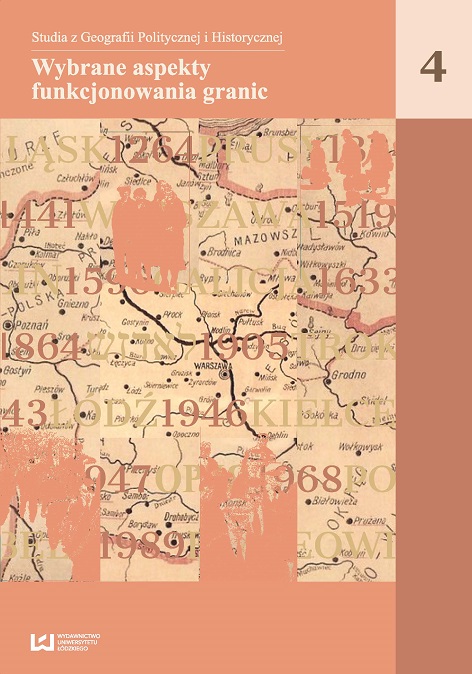The role of the Vistula River as a border on the background of historical divisions of Poland and its importance in the current administrative division
DOI:
https://doi.org/10.18778/2300-0562.04.09Keywords:
borders on the rivers, the Vistula, administrative divisionsAbstract
This work concerns the importance of the Vistula as a border borrowed from nature in historical and current divisions of Poland. Forms of this division have changed over the centuries several times. The first form of spatial government was the so-called neighboring communities – opola. In the Middle Ages there were new forms of organization of space such as a province and castellany. In the following centuries these forms changed and evolved. There were counties, municipalities and provinces. The period of the partitions of Poland, as well as two world wars brought changes to the internal division of the country, imposed by the invader administration. Political boundaries were repeatedly changed too. In many of these divisions, the Vistula River served as a natural basis for the designation of a border. It should be noted, that there are places where the border is more than five hundred years old. The current administrative landscape of Poland is a result of government reforms in 1999, which established a three-tier division of the country. The role of the Vistula as a border in this division is also clearly visible.
References
Babirecki J., 1895, Polska w roku 1771, Kraków.
Google Scholar
Gloger Z., 1991, Geografia historyczna ziem dawnej Polski, reprint, Warszawa.
Google Scholar
Janiszewski M., 1959, Regiony geograficzne Polski, Warszawa.
Google Scholar
Kałuski S., 1992, Rzeki graniczne a kształtowanie się więzi regionalnych w Europie, Warszawa.
Google Scholar
Kałuski S., 1997, Granice polityczne, naturalne i sztuczne – anachronizm czy aktualny problem?, Warszawa.
Google Scholar
Koter M., Kulesza M., 2001, Geographical and historical grounds of formation of borders of former and present-day Poland, [w:] Koter M., Heffner K. (red.), Changing role of border areas and regional policies, Region and Regionalism, No. 5, Łódź–Opole.
Google Scholar
Manteuffel T., 1929, Metoda oznaczania granic w geografii historycznej, [w:] Bachulski H. (red.), Księga pamiątkowa ku uczczeniu 25-letniej działalności naukowej prof. Marcelego Handelsmana, Warszawa.
Google Scholar
Manteuffel T., Dowiat J., 1979, Monarchia wczesnopiastowska, [w:] Tazbir J. (red.), Zarys historii Polski, Warszawa.
Google Scholar
Mielcarek A., 2008, Podziały terytorialno-administracyjne II Rzeczypospolitej w zakresie administracji zespolonej, Warszawa.
Google Scholar
Miszczuk A., 2003, Regionalizacja administracyjna III Rzeczypospolitej. Koncepcje teoretyczne a rzeczywistość, Lublin.
Google Scholar
Olczak E. (red.), 2003, Atlas historii Polski. Mapy i komentarze, Warszawa.
Google Scholar
Olczak E., Sienkiewicz W. (red.), 2006, Ilustrowany atlas historii Polski, t. 1: Od źródeł po schyłek Jagiellonów, Warszawa.
Google Scholar
Piskozub A., 1987, Dziedzictwo polskiej przestrzeni. Geograficzno-historyczne podstawy struktur przestrzennych ziem polskich, Wrocław.
Google Scholar
Piskozub A., 1995, Polska w cywilizacji zachodniej, Gdańsk.
Google Scholar
Piskozub A., 1999, Dziedzictwo tradycji historycznej jako podstawa współczesnej tożsamości regionalnej ziem polskich, referat na XVI Zjazd Powszechny Historyków Polskich, Wrocław.
Google Scholar
Podwińska Z., 1978, Stosunki społeczne i polityczne, [w:] Dembińska M., Podwińska Z. (red.), Historia kultury materialnej Polski w zarysie, t. 1: Od VII do XII wieku, Wrocław.
Google Scholar
Rajman J., Zioło Z., 1992, Przemiany sieci miast regionu górnej Wisły w XIX i XX wieku, [w:] Rajman J., Hempel J. (red.), Wisła w dziejach i kulturze Polski. Studia nad gospodarką i siecią osadniczą regionu górnej Wisły, Warszawa.
Google Scholar
Skrzyp J., 2007, Geografia administracyjna i polityczna, Siedlce.
Google Scholar
Sobczyński M., 1984, Niezmienność dawnych granic politycznych na obszarze Polski, Łódź.
Google Scholar
Sobczyński M., 1994, The influence of past political divisions of the territory of Poland upon the regional structure of the country, [w:] Koter M. (red.), Inner divisions, Region and Regionalism, No. 1, Łódź–Opole, s. 103–116.
Google Scholar
Sobczyński M., 2008, Historia geografii politycznej, [w:] Jackowski A., Liszewski S., Richling A. (red.), Historia geografii polskiej, Warszawa.
Google Scholar
Sobczyński M. Kulesza M., 2006, Miejsce i rola powiatu w tradycji podziału terytorialnego Polski, Łódź.
Google Scholar
Stoksik J., 1990, Wisła pod Krakowem przedmiotem polsko-austriackiego konfliktu granicznego w latach 1780–1782, [w:] Kiryk F. (red.), Wisła w dziejach i kulturze Polski. Studia i materiały z dziejów osadnictwa i gospodarki górnej Wisły w okresie przedrozbiorowym, Warszawa.
Google Scholar
Śliwiński B., 1989, Problem granicznego charakteru Wisły w dziejach Kujaw i Mazowsza do końca XII w. na tle stosunków własnościowo-osadniczych, [w:] Gierszewski S. (red.), Wisła w dziejach i kulturze Polski. Osadnictwo nad Dolną Wisłą w średniowieczu, Warszawa.
Google Scholar
Tazbir J. (red.), 1979, Zarys historii Polski, Warszawa.
Google Scholar
Das deutsche Interessengebiet, 1939/1940, Mapa obszaru interesów niemieckich, Reichsamt für Landesaufnahme.
Google Scholar
Mapa sztabowa M-34-76-A w skali 1:50 000, 1982, Sztab Generalny WP.
Google Scholar
Ustawa z dnia 8 marca 1990 r. o samorządzie gminnym, 1990, Dz.U. nr 16 poz. 95.
Google Scholar
Ustawa z dnia 10 maja 1990 r. Przepisy wprowadzające ustawę o samorządzie terytorialnym i ustawę o pracownikach samorządowych, 1990, Dz.U. nr 32 poz. 191.
Google Scholar
Wojskowa mapa topograficzna w skali 1:50 000, 1982, WZkart, Sztab Generalny WP.
Google Scholar
Geoportal: http://geoportal.gov.pl/ (dostęp 26.05.2012).
Google Scholar
Downloads
Published
How to Cite
Issue
Section
License

This work is licensed under a Creative Commons Attribution-NonCommercial-NoDerivatives 4.0 International License.








